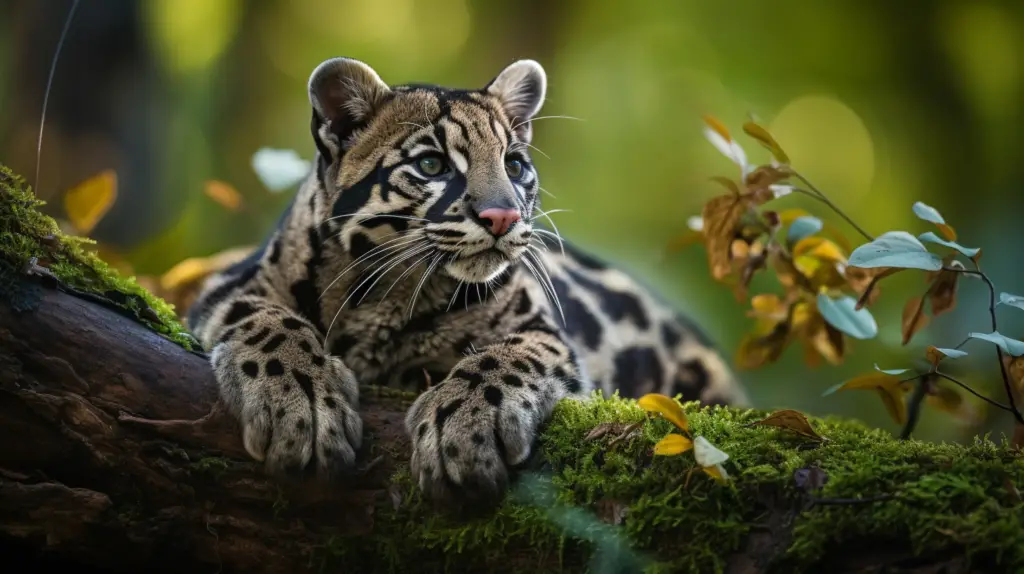The clouded leopard, known scientifically as Neofelis nebulosa, is a captivating and elusive creature that often remains hidden in the realm of big cat knowledge. This fascinating feline is native to Southeast Asia and has intrigued scientists, wildlife enthusiasts, and conservationists for decades. The species is shrouded in mystery, with its cryptic behavior and striking appearance setting it apart in the wild cat kingdom. Despite being less famous than its larger counterparts, the clouded leopard boasts unique characteristics that are equally worthy of admiration and attention.
The International Clouded Leopard Day was established to raise awareness about these beautiful but endangered cats and the threats they face. This event is observed annually on August 4th, bringing together conservationists, wildlife enthusiasts, and communities worldwide.
Now, let’s delve into the forested realms of the Eastern Himalayas and Southeast Asia to discover 25 interesting facts about this enigmatic creature, the clouded leopard.
1. Clouded Leopards Are Named for Their Coat: The clouded leopard got its name from the distinctive ‘cloudy’ patterns on its coat. These blotches, which are unique to each individual, provide excellent camouflage in their forest habitats.
2. They Have the Largest Canines of Any Feline: Compared to body size, clouded leopards have the largest canine teeth of any wild cat. Their fangs can reach up to 2 inches (approximately 5 cm) in length.
3. Arboreal Acrobats: These leopards are skilled climbers. They have short, stout legs and broad paws, aiding in their tree-climbing abilities. Their ankles can rotate backward, allowing them to descend trees headfirst.
4. Excellent Jumpers: Clouded leopards can leap up to 1.2 meters vertically and are capable of making long jumps between trees.
5. Highly Solitary: These creatures are typically solitary outside of the breeding season. They are also mainly nocturnal, adding to the challenges of studying them in the wild.
6. Territorial Markers: Clouded leopards mark their territory by spraying urine, leaving scratch marks on trees, and producing a variety of vocalizations.
7. Smaller Than Other Big Cats: Despite their large teeth, clouded leopards are relatively small compared to other big cats. They typically weigh between 15-23 kg, with males generally larger than females.
8. Diverse Diet: Their diet mainly consists of various mammals like monkeys, deer, and birds. They are also known to eat reptiles and insects.
9. Long Tail: Their tails are quite long—almost the length of their bodies—providing balance while moving through the trees.
10. Dual Habitat: Clouded leopards are comfortable both on the ground and in the trees, showcasing their adaptability in diverse environments.
READ MORE: 25 Interesting Facts about Tigers and International Tiger Day
11. Threatened Species: The clouded leopard is classified as ‘Vulnerable’ on the International Union for Conservation of Nature (IUCN) Red List due to habitat loss and hunting.
12. Subspecies: There are two subspecies of clouded leopards – the mainland clouded leopard (Neofelis nebulosa) and the Sunda clouded leopard (Neofelis diardi), which is found on the islands of Borneo and Sumatra.
13. Distinctive Roar: Unlike other big cats, clouded leopards cannot roar due to the structure of their larynx.
14. Swimming Capabilities: They are strong swimmers and are often found near water bodies.
15. Gestation Period: The gestation period of clouded leopards is approximately 93 days.
16. Young at Birth: Newborns are blind and helpless, with their eyes opening after about 10 days.
17. Cub Development: Cubs become independent at around ten months of age, but they reach sexual maturity between 26 to 30 months.
18. Life Span: In captivity, clouded leopards have a lifespan of 11 to 17 years.
19. Fossil Record: Fossil remains of ancient clouded leopards have been discovered in Taiwan, suggesting a broader historical range for the species.
20. Protected by Law: In many of their range countries, clouded leopards are protected by national laws.
READ MORE: 25 Interesting Facts about Orcas, or Killer Whales
21. Camouflage: The cloud-like patterns on their fur blend perfectly with sunlight filtering through the forest canopy, making them nearly invisible.
22. Strong Jaw Muscles: Clouded leopards have powerful jaw muscles that allow them to hang onto prey with their mouth while their forelimbs are free to strike at other targets.
23. Prey Capture: They often carry their captured prey up trees for consumption to avoid competition from other predators.
24. Size Variations: The Sunda clouded leopard is slightly smaller and darker with larger cloud markings than the mainland species.
25. Conservation Efforts: Numerous organizations, including the World Wildlife Fund (WWF) and Panthera, are working to conserve clouded leopards and their habitats.
READ MORE: 25 Interesting Facts About the Pink Dolphin, aka the Amazon River Dolphin
The clouded leopard remains a symbol of the dense, shadowy forests of Southeast Asia—truly a testament to the intricate and alluring tapestry of nature. Despite the challenges posed by deforestation and poaching, ongoing conservation efforts provide hope for this unique and enigmatic creature. This cloud-walker of the animal kingdom, with its distinctive coat and remarkable adaptability, continues to captivate and intrigue us, reminding us of the extraordinary biodiversity of our planet.



